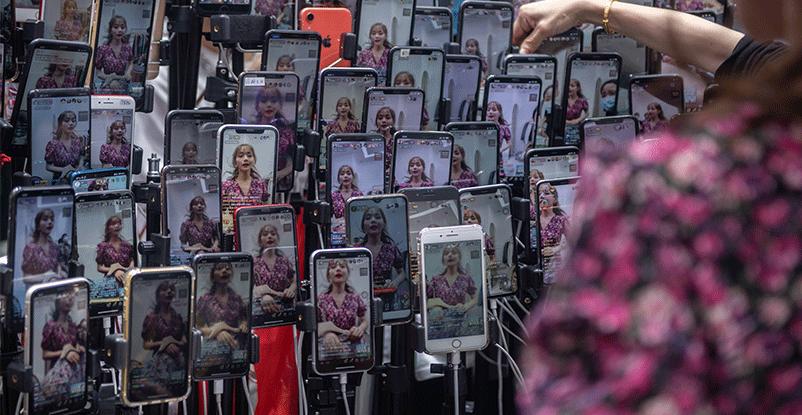Teleshopping is not new. But live commerce, which combines influencers, livestreaming, shopping and social media, has become 2020’s hottest way to shop in China.
“Without the Covid-19 pandemic, the livestream commerce industry wouldn’t have developed so crazily in the first half of the year. The stay-at-home order and shutdowns hampered the offline economy. People had to turn online for a chance. The traditional e-commerce landscape has already been shaped, and only short videos and livestreaming are still undeveloped,” He Haoxun, director of creative content at short-video platform Kuaishou (aka Kwai), told NewsChina.
According to data from the Ministry of Commerce, more than four million livestream shopping sessions were broadcast in the first quarter. In 2019, the livestreaming e-commerce market was worth 440 billion yuan (US$63b), almost 9 percent of China’s total estimated e-commerce sales (US$723b), according to commercial bank Everbright, which predicts the market will double by the end of 2020.
More influencers are raising eyebrows with impressive sales records. On May 10, Dong Mingzhu, who runs China’s largest aircon manufacturer Gree Electric, sold 310 million yuan (US$44m) worth of products in a three-hour livestream on Kuaishou.
Xin Youzhi, known as Simba by his 51 million fans on Kuaishou, sold an estimated 1 billion yuan (US$145m) in cosmetics, kitchenware and food during his five-hour livecast on June 14, livestream e-commerce data platform Bihukankan reported. During a June 8 livestream, high-profile influencer “Xiaoyiyi,” who has 36 million fans on Kuaishou, sold 105 million yuan (US$15.2m) in luxury goods from Rolex, Hermes, Louis Vuitton, Prada and Armani.
Multi-channel networks (MCNs) are firms that work with social media platforms to attract new followers and provide influencers and content. Like a talent agency, MCNs train the influencers, also known as key opinion leaders (KOLs). The vast majority of top-tier and mid-tier influencers in China work with an MCN. It can be difficult for brands to work with KOLs without going through an MCN.
According to a 2020 survey on the MCN industry in China from Beijing-based data vendor TopClout, there are more than 20,000 MCNs in China, up about 400 percent year-on-year.
But in this industry, data determines a host’s value. Indicators include gross merchandise volume (GMV), numbers of transactions, viewers and their duration of view. A host with favorable data demands higher commissions and has more leverage when setting prices.
Data manipulation has long been a pervasive issue in the digital economy. But according to Zhao Yuanyuan, former operations manager of Taobao Live, the astronomical figures coming from livestreaming e-commerce are even more suspect.
“Now it’s not even worthwhile writing a news report unless sales from a livestreaming session are in the tens of millions of dollars,” Zhao told NewsChina.
“Sales of discounted items or 50 percent-off goods are calculated based on their original prices. Page views are counted among the number of online viewers. Everyone brags about their figures, miracle this, miracle that. But on top of all the marketing, high commissions and low prices, how much money can brands actually bring in?” Zhao said.
There is a whole cottage industry for faking livestreaming data. E-commerce vendors can fabricate statistics such as number of page views, online views, fans and comments. For instance, 7 yuan (US$1) buys 100 fake views, while 129 yuan (US$17) conjures 10,000 views.
Many hosts employ teams to fabricate data to attract more retailers and demand higher fees.
“When considering the commercial value of a host, many brand owners only care about the number of followers and online views, but these are easily fabricated. Very often the brands find they’ve been cheated when the hosts they hired prove to be bad at selling,” said Liao Qingqing, founder of the Guangzhou-based MCN firm Guangfeng Jiyue.

 Old Version
Old Version




